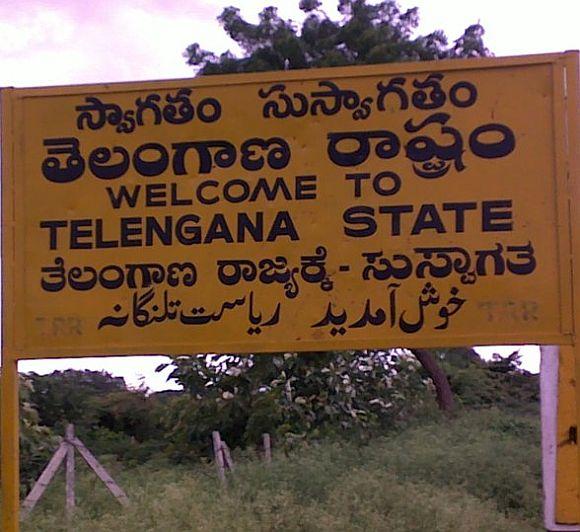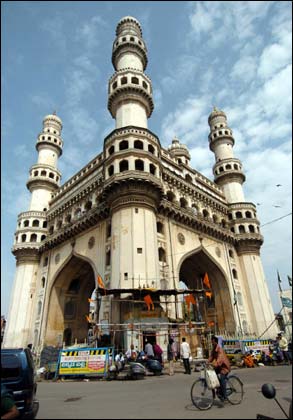 | « Back to article | Print this article |
'I was there, 44 years ago, when the Telangana agitation started'
Mahesh Vijapurkar was a student in Hyderabad when the Telangana agitation began, with Osmania University as its epicentre. With the new state finally set to become a reality, he looks back on the lost years
I was there, a fly on the wall, when the agitation for statehood for Telangana started and gathered gale force. Violence was part of the tactics, and then as now, Osmania University was where the action was. Student leaders had as much say on the course of the stir, its intensity, and even tactics as much as on the level of violence.
Initially, when leaders like G Mallikarjun, a medical student, came to our college to canvass support and participation, he was cold-shouldered, for academics were considered important. But like in all agitations, the rest who are spectators also get swept into the whirlwind. Later he became a minister for railways, winning the Medak seat on the statehood platform.
In retrospect, it can be said that if the statehood for Telangana is justified now, 44 years later, then it was certainly warranted then. The delay of decades and the agitation for separation of what is now called Seemandhra from linguistic Andhra Pradesh in 1971 played havoc with students. They lost a clear year.
Click NEXT to read further...
'I was there, 44 years ago, when the Telangana agitation started'
When the then most important newspaper of the city, Deccan Chronicle, went for carpet coverage, with its chief reporter Pratap Kishore becoming the coordinator of the Telangana Praja Samiti, the idea took hold among the most common people. Even if traumatic, most began to see the justification for statehood, unless they happened to be from outside the former Hyderabad State.
My batch, which joined the degree course in 1969, should have had the convocation in 1971 but it was delayed by a year. Examinations were delayed, they ate into the subsequent academic years, and a year was lost. That was a dear price paid without a gain; only those who made a political career of the issue gained.
Like Mallikarjun did. Like other eight who went to the Lok Sabha on the statehood platform, on the Telangana Praja Samiti ticket. Chenna Reddy became chief minister, and soon, he blended into the Congress ethos, and the statehood as an issue surfaced only intermittently. It gathered momentum decades later for the decisive last push with the formation of the Telangana Rashtra Samiti in 2001.
The Hyderabad of the late 1960s -- as much as rest of the region of Telangana -- was as much laid back as it was during the Nizam’s rule. Being laid back was a part of the nature of being a Hyderabadi. The language was a distinct Dakkani Urdu and the Telugu was liberally peppered with it. One did not need a Telugu Professor Henry Higgins to spot a person from Telangana. Now, I am hard put to spot one.
The badge of honour for us then was possession of a mulkhi certificate, which was nothing but a domicile certificate. Though Andhra Pradesh, the first linguistic state, was formed in 1956, Urdu usage was fairly extensive and some terms remained in use with the administration. A revenue official did not survey crops for estimates of yield, he did an azmaish. Those who did not have a mulkhi (of the mulch) were different from us.
The predecessor state was the Telugu areas minus Telangana, with Kurnool as its capital. It was the coastal Andhra as well as Rayalaseema, carved out of Madras Presidency in 1952. When the larger linguistic Andhra Pradesh came to be, the capital easily shifted to Hyderabad, the largest, then relatively the most developed city; it had to be, having been the capital of the Nizams. With that came people who spoke differently, and with them came a slow trickle of investments since Seemandhra was agriculturally richer.
Click NEXT to read further...
'I was there, 44 years ago, when the Telangana agitation started'
The Telangana Praja Samiti merged with the Congress on small concessions like (external link) the 6-point formula of 1973, which sought to protect the interests of the locals, promote equity between regions, and made an attempt to make everyone happy. But that was illusory to the Telanaganwallahs, for even the written rule can be sabotaged. Dissatisfaction remained; backwardness outside of Hyderabad compared to other parts of the state was an enduring fact, even today.
When chatting up a classmate, he told me how even well into the start of the new millennium he had travelled into the districts outside of Hyderabad. He found, “to put it bluntly, only squalor” and lack of any significant investment. Hyderabad “is only a window-dressing for development” and the money came from the coastal and Rayalaseema regions. This surged when the Telugu Desam led by NT Rama Rao, winning an election on the ‘Andhra pride’ platform, after a chief minister from Telangana, T Anjaiah, was snubbed by Rajiv Gandhi.
During the first flush of the agitation, when the Osmania University tried to push through examinations despite the disruptions, unprepared students brought to it the phenomenon called mass copying. Uncertain teachers, having seen the violence on the streets carried out by students, just winked and later job advertisements put in a condition: graduates of Osmania University needn’t apply. That hurt everyone.
As a person born in Hyderabad and raised in the tehzeeb of the region, where a mayor’s job was only part-time, and civic affairs was not politics, the delay of four decades is unconscionable. The delay hardened positions, created new vested interests, and it now makes the investors from Seemandhra quite queasy -- which explains the opposition to the formation of the new state.
However, there is a new challenge. Would the leaders, who would take up the stewardship of the new state after having complained of neglect, backwardness et al, make sure that Adilabad, for instance, which remains much in the boondocks now as then, would catch up with Hyderabad in the next one decade? That would be the true test of the political class. If they did not bring such districts up, especially because it would be a smaller administrative unit, then the demand for Telangana has been just politics, not a hankering for development.
However, Telangana is not a deal signed and delivered today. There are processes to go through, bills to be passed, including by the Andhra Pradesh legislature which has to make a reference. There are issues of reparations to settle, debts and assets settled between the two parts of today’s Andhra Pradesh. The insecurities of the Andhras as distinct from the Telanganas have to be addressed during the process, their goodwill retained.
But it is certainly in the last lap, 44 years later. Hopefully, when the new state is born, it would not be for the politicians’ gain, but the people’s.
TOP photo features of the week
Click on MORE to see another set of PHOTO features...



